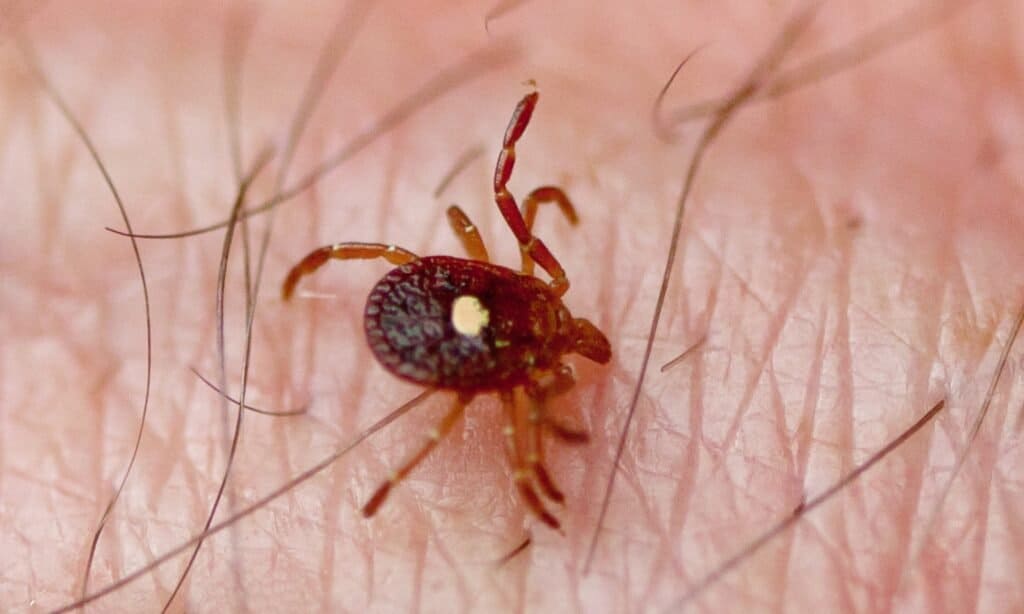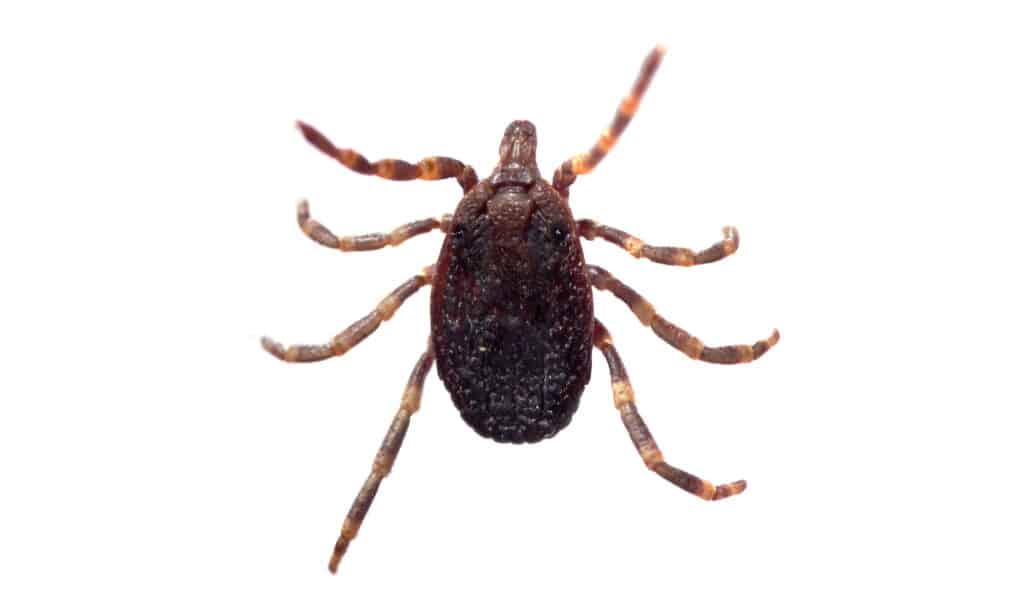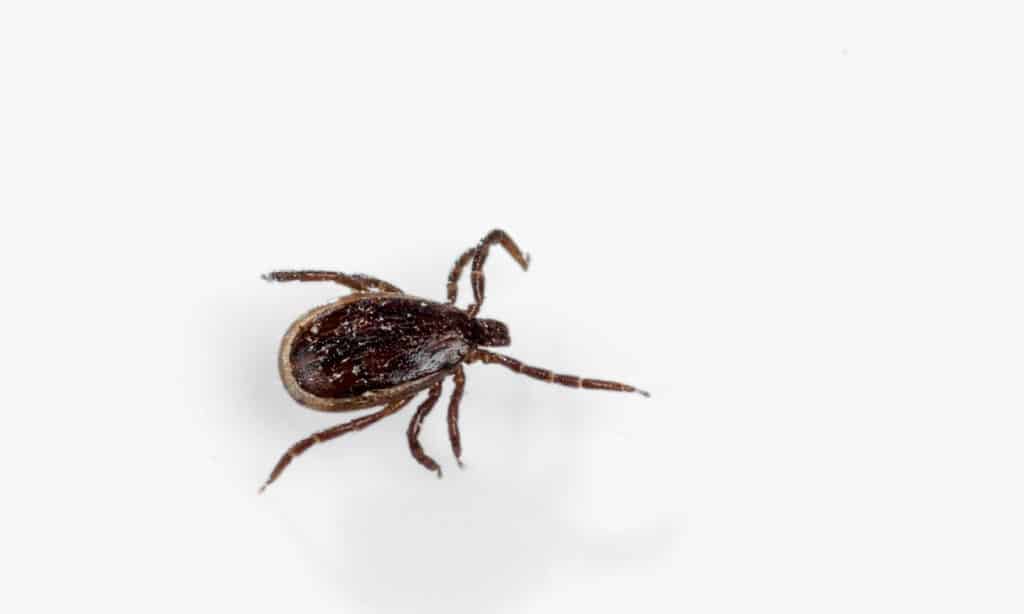There is nothing more unpleasant than having to deal with ticks. A tick may be small, but it can cause serious problems if you come into contact with one. Besides being unpleasant to look at and overall creepy, ticks can spread diseases as well. However, this is exactly the reason why you should begin paying attention to them in the first place. It’s common to find ticks in tall grass and wooded areas.
So how much do you know about ticks? In this article, we’ll take a look at how many legs ticks have and what purpose they serve. By understanding how ticks work and how to protect yourself from them, you’ll be able to prevent them from causing harm to you. In order to better understand ticks, let’s begin with a visual guide.
What Do Ticks Looks Like?

It is possible for ticks to bite at all three stages of their life cycle.
©iStock.com/epantha
A tick is an arachnid, which means that it is closely related to spiders and mites. In fact, a tick’s appearance is remarkably similar to a spider’s. It lacks an antenna, just like spiders, and different species of ticks will reach different sizes. A black-legged tick’s larvae are about the size of a grain of sand, while a nymph is about the size of a poppy seed, and the adults are about the size of a sesame seed. It is estimated that an adult female black-legged and/or lone star tick can be as large as a raisin when it is fully fed.
The length of an adult tick is usually between 2 and 6 mm. There are many different colors of ticks, including grayish-white, brown, black, reddish-brown, and yellowish. It is possible for female ticks to change color when they are enlarged after feeding. Deer ticks filled with blood turn reddish-brown or rusty colored, while dog ticks fattened with blood turn gray or grayish-blue.
Let’s look at how many legs ticks possess now that we know how ticks look.
How Many Legs Do Ticks Have?

Ticks have six legs when they are larvae and eight legs as adults.
©iStock.com/digitalg
The tick, as we mentioned before, is not an insect, but an arachnid, which means it is related to spiders and mites since it has no wings. In their larval phase, they only have six legs. However, once they reach adulthood they have eight legs. Is there a reason why ticks have so many legs? Is it because they are parasites? Let’s take a look at how ticks make use of their eight legs.
Why Do Ticks Have So Many Legs?
Due to their small size and relatively flat body, ticks can attach easily to hosts and eat their fill before they are noticed. An adult tick has eight legs, each covered with short, spiny hairs and ending in a tiny claw. There are two main purposes for these spines and claws. Their purpose is to assist ticks in grabbing grass blades, leaves, branches, and other vegetation. As a consequence, ticks are also able to grasp their hosts when they attach to them.
The mouthparts of ticks are used to pierce the skin of their hosts and extract blood. Species will have different mouth parts, but in general, a tick’s mouth will have two palps, which move out of the way during feeding and don’t pierce the skin of its host. There are also two cutting teeth, known as chelicerae, and one needle-like, barbed hypostome.
Let’s take a closer look at how ticks transmit diseases now that we understand how ticks use their legs to feed.
How Do Ticks Transmit Disease?

Ticks spread disease when they digest blood from a host that has a blood illness and continues to spread that to other hosts.
©iStock.com/VladK213
During the feeding process, ticks transmit disease-causing pathogens. Depending on the tick’s species and life stage, preparing to feed can take anywhere between 10 minutes to 2 hours. Once it finds a feeding spot, the tick grabs the skin and cuts through it with its chelicerae. Hypostomes, which have grooves on them to draw blood, are barbed feeding tubes that ticks inject into their hosts.
As part of their defense, many species secrete a hardening substance in their salivary glands that hardens quickly. This helps keep them attached to their host during meals. Each species of tick feeds at a different speed. Lone star ticks, for example, begin feeding fairly quickly, while blacklegged ticks take several days to feed. When a tick ingests blood from a host animal with bloodborne infections, it will spread the infectious diseases to future hosts. The tick’s saliva may also get on the host’s skin when it feeds. Through this method, pathogens can be transmitted from the tick to the host animal as well.
Signs That You Have Been Bitten By A Tick
There are ticks everywhere these days. In fact, Hawaii is the only state in the United States that doesn’t have Lyme disease, an illness spread by ticks. According to the Centers for Disease Control and Prevention (CDC), 476,000 Americans became ill with Lyme disease in 2021, and the number of cases has more than quadrupled since 1990. The process of detecting tick bites can be challenging. Unlike mosquito bites and other insect bites, tick bites do not cause immediate itching or skin irritation.
So how can you know if you’ve been bitten by one? You should keep in mind that all arthropods and insects that feed on blood introduce saliva into the wounds. Because saliva is present, the bite wound cannot clot because of specific proteins in it. Without these proteins, the blood flow would slow and cause the tick to become unable to eat. Additionally, these proteins act as immune system stimulants since they prevent blood clotting. As a result of this reaction, you can expect redness, swelling, itching, and other unpleasant skin irritations caused by a tick bite.
If the tick is on you, you’ll definitely see it and be able to remove it. However, if it has already detached, keep an eye out for red welts or itchy lesions. Consult a doctor if the rash is larger than a highly localized red spot or if you start experiencing flu-like symptoms. A doctor will prescribe antibiotics if he or she suspects you may have contracted Lyme or some other infection from a tick bite.
How To Prevent A Tick From Biting You
There is a wide variety of habitats where ticks can prosper. It is common to find ticks in woodlands and coastal areas, as well as in low grasses and shrubs. The presence of ticks is most prevalent in areas that are grassy, bushy, and heavily wooded. You are best off staying away from those environments if you want to avoid getting bitten by a tick.
While it’s always best to avoid grassy and woodland areas, it’s not always possible. Those who love the outdoors may find this especially true. One of the best ways to enjoy nature is to go on hikes and explore the wilderness. You should wear long pants and boots if you go into such areas, and you should take them off as soon as you get back home. The next thing you should do when you get back home is to put your clothes in a high-heat dryer. There is evidence that ticks can survive washing and drying since they love humidity. However, if you put your clothes in the dryer without wetting them, the dry, hot conditions will kill them.
It is also possible to protect yourself against ticks by using DEET and other bug repellents. Ticks can be effectively killed on contact with a chemical called permethrin, which is available as a spray. Tick bites can be reduced by taking all of these steps into account, even though they are not always 100% effective. It’s important to do everything you can to minimize your risks and to keep the outdoors as enjoyable as possible.
The photo featured at the top of this post is © iStock.com/CarolinaSmith
Thank you for reading! Have some feedback for us? Contact the AZ Animals editorial team.






